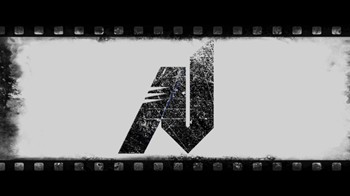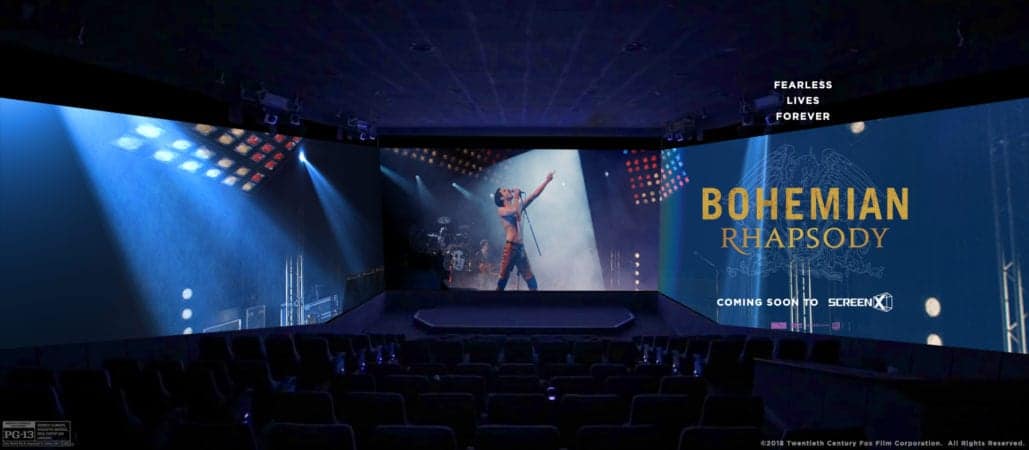Before the discussion of ScreenX begins, we need a preface. In the decade since Christopher Nolan popularized filming with IMAX cameras in The Dark Knight, the major Hollywood studios have incrementally hedged their box office hopes on Premium Large Format (PLF) theaters as their key to success. While the ubiquity of IMAX remains undisputed, theater chains such as AMC and Cinemark offer similar, less expensive alternatives.
PLF screenings such as AMC Prime, Cinemark XD, and Dolby Atmos have compensated for a major portion of ticket sales on several blockbusters this year. Two weeks ago, Halloween broke out with a $76 million opening weekend with healthy PLF revenue, but no IMAX screens. The response was so big that Universal booked a one-week IMAX engagement for the film in its second weekend. Dolby Atmos has pivoted event films, but it does the trick for smaller or less obvious fare. A Star is Born’s raging sound mix could have drowned out someone making a feature-length phone call; even the Kevin Hart/Tiffany Haddish comedy Night School got a benefactor from big-city Atmos engagements.
Enter CGV. The South Korean theater chain is the fifth largest in the world, but their stateside footprint is limited to two locations in Los Angeles and one in New York City. Their answer to PLF is ScreenX, “the world’s first multi-projection movie theater… for an unparalleled immersive movie viewing experience,” according to their site. The 270-degree display overlaps around the walls, a 21st century successor to the spectacle of Cinerama.
The Cinerama comparison is bold enough, but can ScreenX stand out in a proverbial land of giants?
What it was like seeing Bohemian Rhapsody in glorious ScreenX.
I had the pleasure of visiting the ScreenX at CGV’s Los Angeles location on Thursday night. Located on Western Avenue in the heart of Koreatown, ScreenX has plenty of competition in the epicenter of the film industry. From Hollywood Boulevard’s historic TCL Chinese Theatre and Grauman Egyptian Theatre, to the magnitude of Universal Studios’ AMC IMAX theatre and Arclight Hollywood’s Dolby Atmos-equipped Cinerama Dome, Los Angeles offers no end of destination venues for films.
Arriving at the theater, the arcade phantasmagoria of a garden variety multiplex is absent. Perched on the third floor of a mini-mall just south of 6th Street, CGV’s aesthetic is refreshingly minimalist, akin to an art gallery with off-white walls and sleek, wood floors. Concessions carry an intimidating price, but in addition to popcorn and soda, CGV offers cultural specialties such as seaweed crisps and squid snack, distinguishing the menu from major theater chains.
Tonight’s film, the maiden voyage for ScreenX in the United States, is Bohemian Rhapsody, the buzzed-about story of legendary rock band Queen and their iconic frontman, Freddie Mercury (Rami Malek). It is the only film at the three-screen theater in the English language. The film is preceded by two trailers, Fantastic Beasts: The Crimes of Grindewald, which opens at CGV in two weeks, and next year’s Shazam! The anamorphic ratios are windowboxed in a 1.85:1 screen. These are followed by a bilingual etiquette reminder and two short, Korean-language ads for Hyundai’s Genesis luxury vehicles.
The film begins
At 7:10 pm, the curtains open and the screen widens to the film’s proper 2.39:1 aspect ratio. ScreenX is demonstrated in a mesmerizing short, where a young girl uses a crystal cube to project the image of a city. The film begins with the 20th Century Fox logo and the fanfare redone as a Queen-style rock piece. It is, perhaps, the first time since The Rocky Horror Picture Show in 1975 that Alfred Newman’s earworm has been made over in this fashion. The film features Korean subtitles.
However, the novelty quickly wore thin after the opening credits. Teased as innovation before the film, the parts of Bohemian Rhapsody that utilize the ScreenX technology are ugly and disorienting. During early concert scenes, there is a Cinerama effect, a sort of psychedelic concert feel, but I realized something was not right.
Indeed, when the film reaches the moment where the eponymous song is recorded and released, there is a part of the montage where critic blurbs fill up the screen. These blurbs first appear on the conventional screen, then bleed into the lower-resolution, zoomed-in sides. As the film went on and chose to utilize the technology at random, that was where I began to notice the true flaws of ScreenX.
As if the side-wall projection was disappointing enough, a closer look revealed that the 2.39:1 aspect ratio had been slightly matted, as had the side walls, to accommodate the illusion of ScreenX. If you are still holding on to that old DVD of The Abyss and know the feeling of having to zoom into the image to make a crude, anamorphic frame, that is what ScreenX’s bells and whistles look like.
The hits just keep coming
It gets to a point of distraction—during a scene where Freddie is bugged at a press conference about his sexuality, camera flashes emitted from the sides like dull shooting stars without anything else on-screen. It’s almost as if the theater gives a reminder to turn off your cell phones to suppress audience interference, only to create new concentration hurdles with the exhibition.
CGV takes a further hit with the main projection of the film. To clarify the technical specs and why this experience was so disappointing, Bohemian Rhapsody is director Bryan Singer’s tenth consecutive film with cinematographer Newton Thomas Sigel, who has lensed for Singer since 1995’s The Usual Suspects. They filmed with two Arri cameras in a 2.39:1 aspect ratio. A third of the film was shot on Arri’s “future proof,” 4K and HDR-capable ALEXA SXT. The rest of the film used the premium, 65mm ALEXA 65 series for production. The PLF-friendly 4K digital intermediate is accompanied by a Dolby Atmos sound mix.
Seeing Bohemian Rhapsody in ScreenX, assuming that Singer and Sigel strived for cutting-edge filmmaking is a moot point. Some scenes were clear to see the fine-grain detail of the ALEXA 65’s prime lenses, especially on period costumes. Due to the nature of ScreenX and its compressed frame, the image remained flat and soft with no flourish.
Worse yet, for a film about one of the greatest rock groups to walk the earth, the sound is standard at best. Except for the sequence where the band performs “Another One Bites the Dust,” the sound felt produced from a bargain-priced soundbar. Even the film’s triumphant Live Aid finale sounded half-asleep. I’m not sure about you, the reader, but when I go watch a movie about the band that gave us “I Want It All” and the Flash Gordon soundtrack, I want it so loud that I can’t even think.
To be fair, let’s compare…
For comparison, in the past few months, I have seen several films presented in competing PLF formats. The aforementioned IMAX theatre at Universal Studios is like VR without the headset. At the premiere of Luca Guadagnino’s Suspiria, the Cinerama Dome’s Dolby Atmos capabilities and curved screen opened a door to a waking nightmare. As earlier mention, I saw A Star is Born, this fall’s first awards-friendly music film, in Dolby Atmos at the AMC Burbank 16. You felt lived in to the rock and roll lifestyle that Ally and Jackson Maine fall in love against. Even the simple, effective acoustics of stereo tracks on archival 35mm prints I’ve seen at Los Feliz’s Vista Theatre are livelier.
For purists, ScreenX puts Bohemian Rhapsody at a native disadvantage. Like fellow big 2018 IMAX tickets Black Panther, Avengers: Infinity War, and Mission: Impossible – Fallout, select scenes were filmed by Singer in the 1.90:1 IMAX ratio. To forego that kind of presentation for $4-6 less on an inferior PLF presentation is an unwise move. ScreenX is an ambitious concept, but it offers no reward to its novelty. The effort to achieve this gimmickry is such that it breaches the filmmakers’ intentions, which, in a city built on entertainment, is an insult.
I walked in with an open mind. I walked out feeling pressure on my skull from trying to absorb the concept of a 270-degree screen. To paraphrase Queen themselves, it’s no kind of magic. Should you plan to spend $20 or more on Bohemian Rhapsody, Rami Malek’s larger-than-life portrayal of Freddie Mercury deserves to be seen and heard without technical tampering.



